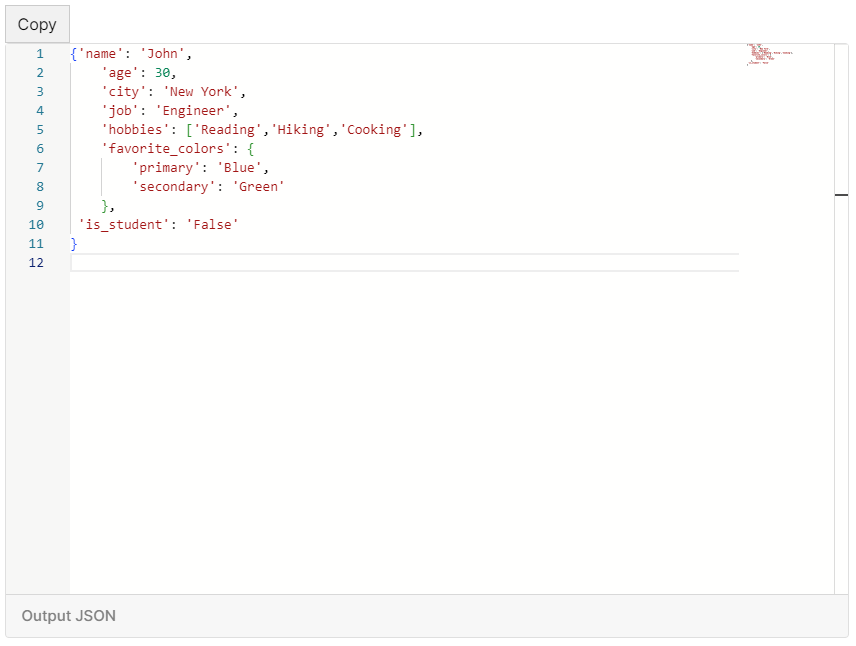🐍 JSON ⇄ Python Dict Converter
🐍 What is a JSON to Python Converter?
Convert JSON to Python dictionaries and lists, or turn Python objects back into JSON! Perfect for data science, web development, and automation scripts.
🚀 How to Use This Tool
- Paste your JSON or Python dict into the editor.
- Click the conversion button to switch between JSON and Python formats.
- Copy or download your result instantly!
💡 Pro Tip: Use the format and paste buttons for a faster workflow!
What is a dictionary in Python?
In Python, a "dictionary" is a fundamental and versatile data structure used to store and organize information efficiently. It is commonly known as "dict." Unlike ordered sequences like lists and tuples, a dictionary is an unordered collection of elements, but what sets it apart and makes it extraordinarily valuable is its ability to store data in key-value pairs. Each element within a dictionary consists of a unique "key" and its corresponding "value." This key-value relationship allows for fast and efficient access to data because, instead of using numeric indexes, data is retrieved using its keys, which can be of various types (for example, strings, numbers, or tuples).

Difference between a dictionary in Python and JSON
A dictionary in Python and JSON (JavaScript Object Notation) are two data structures that share similarities, but also present fundamental differences in terms of their definition, use, and application context. These are the key differences between the two:
Programming language:
- Dictionary in Python: It is a native data structure in Python that allows storing key-value pairs, where the keys are unique and the values can be of any data type.
- JSON: is a language-independent data exchange format and is commonly used to transmit data between systems on the web. Although it is supported by many languages, its notation originated in JavaScript.
Syntax and Notation:
- Dictionary in Python: It is defined using curly braces {} and contains key-value pairs separated by colons:. For example: my_dictionary = {"name": "John", "age": 30}.
- JSON: Uses similar notation with curly braces {} and colons:, but unlike Python, keys must be enclosed in double quotes. For example: {"name": "John", "age": 30}.
Use and Application:
- Dictionary in Python: It is mainly used as a data structure in Python applications to organize and access data in the language itself. It is an integral part of Python programming.
- JSON: It is used in applications where data exchange between different systems and languages is required. It is common on the web to transmit data between servers and clients, and is also used to configure applications and store structured data.
Compatibility:
- Dictionary in Python: It is specific to Python and is not directly understood in other languages.
- JSON: It is widely supported by many programming languages. Most modern languages have libraries for parsing and generating JSON data.
Why Use a JSON to Python Converter:
A JSON to Python converter is an essential tool in the world of programming and data analysis, and its adoption is justified for several fundamental reasons:
- Data Interoperability: JSON (JavaScript Object Notation) is a data exchange format widely used in web development and inter-system communication. Using a JSON to Python converter achieves efficient interoperability by allowing JSON data to be seamlessly integrated into applications written in Python. This makes it easy to integrate data from external sources, such as web services, databases, and third-party systems, into your Python projects.
- Facilitates data processing: Python is a programming language known for its simplicity and power. Converting JSON data into Python structures such as dictionaries or lists opens the door to a wide range of functions and libraries that allow you to manipulate and analyze data efficiently. This includes the ability to access nested values, filter data, perform calculations, generate reports and visualizations, and much more.
- Integration into existing applications: JSON to Python converters make it easy to embed JSON data into existing Python applications. This is especially valuable for developers who want to extend the functionality of their web or desktop applications by incorporating JSON data, as it allows them to work with this data natively in the Python language.
- Data structure flexibility: Converters provide the flexibility to choose between converting JSON to dictionaries (for data with key names) or lists (for data structured as arrays). This allows them to adapt to a wide variety of scenarios and data structures.

